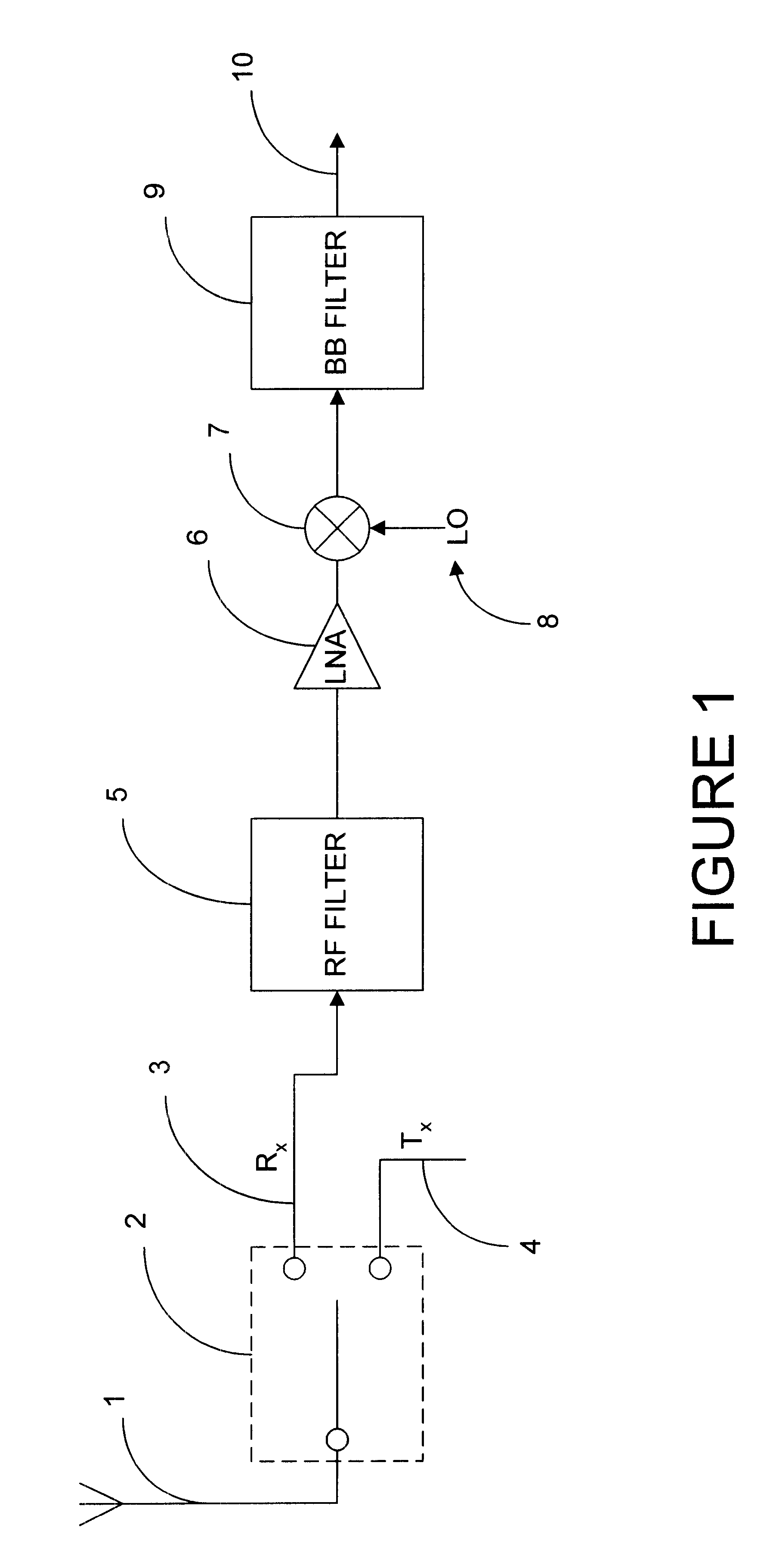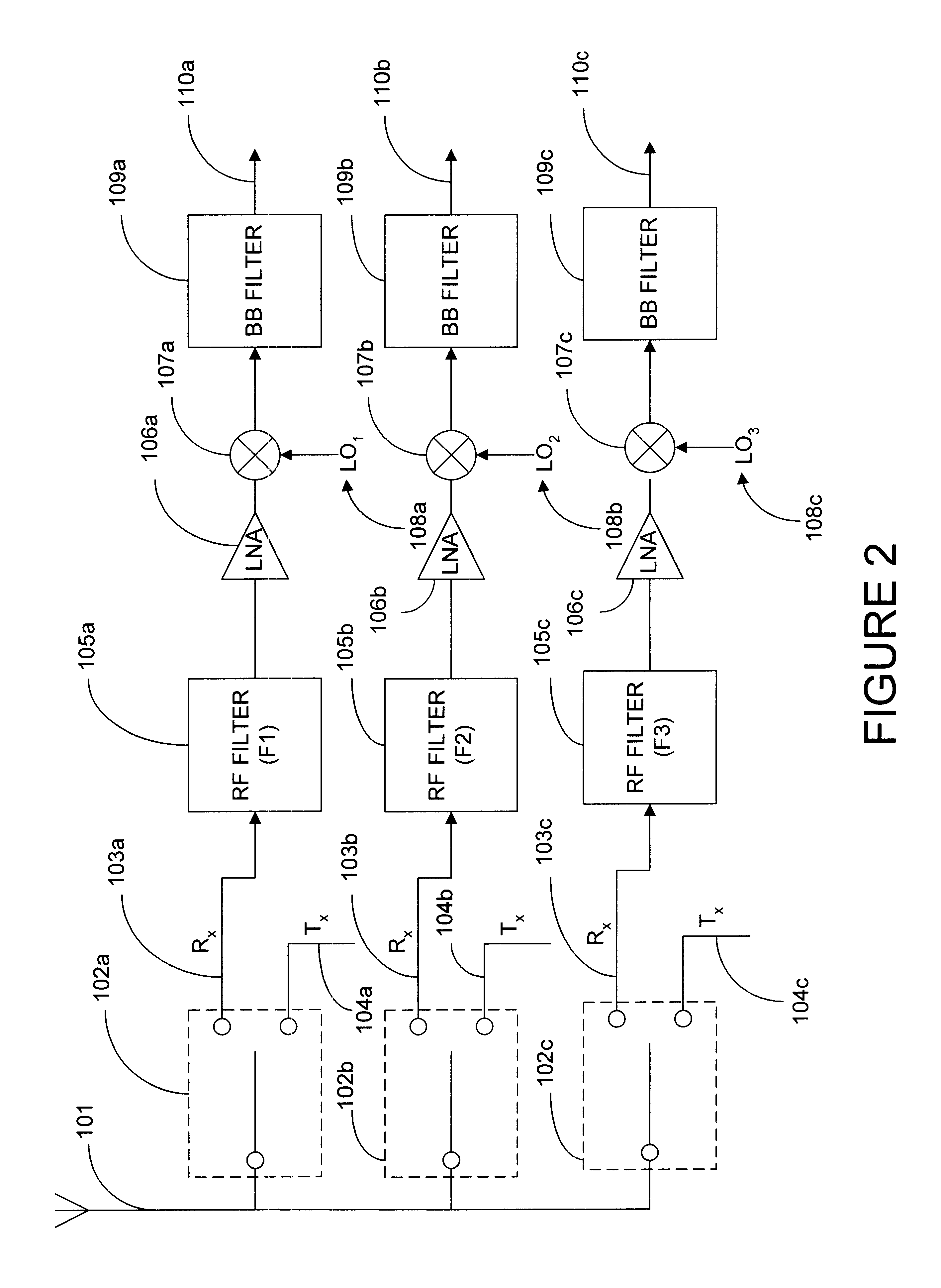Multi-band filter system for wireless communication receiver
a filter system and wireless communication technology, applied in the field of mobile wireless communications receivers, can solve the problems of excessive loading of receiver components, no one of these three standards has yet achieved universal worldwide coverage, and the excessive space consumed by receiver components for the three different bands
- Summary
- Abstract
- Description
- Claims
- Application Information
AI Technical Summary
Problems solved by technology
Method used
Image
Examples
first embodiment
a method of implementing the system of FIG. 3 is illustrated in FIGS. 4A-4C, in conjunction with FIGS. 8A-8B. In a first step, illustrated in FIG. 4A, the input impedance of filter 205a is measured at the center frequency f.sub.2 of filter 205b. This value is referred to as Z.sub.in (f.sub.2). Then, the length of line 211a, L.sub.1, is determined so that the input impedance of filter 205a as adjusted by line 211a at the center frequency of filter 205b, Z.sub.in (f.sub.2)*, appears infinite. This step is illustrated in FIGS. 8A-8B, which illustrate a representation of Smith chart 600, normalized with the characteristic impedance of the material used for line 211a. The perimeter of the Smith chart is identified with numeral 602, the unit circle on the Smith chart is referred to with numeral 604, and the horizontal axis on the Smith chart is referred to with numeral 601. With reference to FIG. 8A, the impedance of the filter 205a, at the center frequency of its passband, f.sub.1, is id...
second embodiment
a method of implementing a filter system of the subject invention is illustrated in FIG. 5A. This figure represents a procedure which is employed for one or more ports, whether input or output, of a filter within a filter system of the subject invention. In step 400, the phase of the reflection coefficient .GAMMA. (or the parameter S.sub.11) at the port of the filter is measured. In step 401, the required length of a transmission line to be coupled to that port is determined based on the phase change which is required to achieve the electrical appearance of infinite appearance at an opposing frequency, that is, a frequency representative of or characteristic of the passbands of one or more other filters within the filter system of the subject invention. Then, in step 402, a transmission line of the length determined in step 401 is coupled to the port of the filter.
third embodiment
FIG. 5B illustrates a method of implementing a filter system of the subject invention. Again, this method is preferably utilized for one or more ports of at least one filter of the filter system of the subject invention. In step 500, the frequency of a network analyzer is set to an opposing frequency, that is, a frequency representative of or characteristic of the passbands of one or more other filters within the filter system is determined. In step 501, the phase of the network analyzer is calibrated or "zeroed" while disconnected from the filter in question. In step 502, the network analyzer is used to determine the phase of the reflection coefficient at the port of the filter. In step 503, the phase change required to achieve the electrical appearance of infinite impedance at the port of the filter is determined, and the required length of a transmission line in terms of wavelength is determined from that phase change. In step 504, the length from step 503 is translated into a ph...
PUM
 Login to View More
Login to View More Abstract
Description
Claims
Application Information
 Login to View More
Login to View More - R&D
- Intellectual Property
- Life Sciences
- Materials
- Tech Scout
- Unparalleled Data Quality
- Higher Quality Content
- 60% Fewer Hallucinations
Browse by: Latest US Patents, China's latest patents, Technical Efficacy Thesaurus, Application Domain, Technology Topic, Popular Technical Reports.
© 2025 PatSnap. All rights reserved.Legal|Privacy policy|Modern Slavery Act Transparency Statement|Sitemap|About US| Contact US: help@patsnap.com



